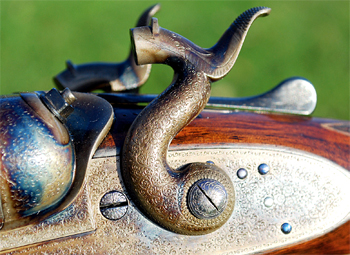1876 Purdey hammergun review

1876 Purdey hammergun review
Manufacturer: Purdey
Sometimes in these pages we like to look at something special, and this months test gun, owned by Colin Jaques and bought from the Cotswood Gun Room, certainly qualifies.
It is serial number 9551, a Purdey bar-in-wood hammer gun made in 1876, some years before the advent of the famous Purdey-Beesley gun – one of the most influential shotgun designs of all time.
This is a gun of great charm, which has been sympathetically restored.
One sees a lot of great old guns done up by less than expert craftsmen. This is not one of them. The only things that I would pick on are the heads of the lock retaining screws, which could do with replacing.
One poor screw head – and these are partially obscured when the hammers are down – can spoil the overall effect all too easily. Replacing and re-engraving screws is not an expensive job, but it can be a bit of an irritation in that it can create a logjam in a renovation schedule.
Although it predates the famous Beesley hammerless action already mentioned, it is still a very usable shooting tool. Colin plans to shoot both game and clays with it.
It was, of course, made in an era of great invention – the era in which the form and mechanism of the modern sporting gun was established. It all happened in the four decades from about 1850. There was rapid change, as one might equate with computer technology today.
From 1890, however, the job was done; there were only changes of detail as far as side-by-side design and style were concerned.
The action of this gun has rebounding hammers and a top lever – both very useful features. A few Purdeys were fitted with thumb-levers after 1867, but the majority had a top-lever from this date on.
Rotary under-levers, thumb-levers, and side-lever guns were seen previously.
The side-lever guns worked off the same mechanism as the thumb-lever types, but with a linkage to the side.
The test gun also incorporates the famous Purdey double bolt and Scott spindle, a system which became near universal on side-by-side guns and is seen in the great majority of sidelocks and boxlocks to this day. There was some evolution in this as one might expect.
The bolting system evolved from one where a lever came out about mid way on the action bar. This was not terribly convenient, so soon after its appearance in 1864 the marriage with the Scott spindle was made.
The gun weighs in at 6 pounds 13 ounces, but feels considerably lighter, as well-balanced guns often will. The barrels are an unusual length at 29.5⁄8.
Sometimes an odd length an eighth or quarter inch off the mark can indicate a pin-fire conversion. Purdey made pin-fires as late as 1873. I had a Purdey gun with barrels one eighth of an inch short of the full inch at 30.7⁄8, and the firm kindly discovered that this rotary under-lever gun dating from the late 1860s had indeed been converted.
The style of action and the record book showing the gun made at 31 confirmed this.
The test gun, however, has not been converted. It appears that its Damascus barrels, which carry slight choke, have been shortened – probably because of damage. They have subsequently been nitro-proofed for 2.1⁄2 cartridges.
The woodwork of this Purdey is most interesting. Bar-in-wood guns always fascinate me. David Maynard, a mine of information on vintage Purdeys, told me: Purdey did lots of bar-in-wood hammer guns and they are very beautiful. The stocking of any bar-in-wood gun is a tour de force in the stockers art.
Those who have had to restock bar-in-wood guns will know this. Wood selection is paramount – strength in the bar area trumps figure.
On a number of occasions, I have seen bar-in-wood guns with a longitudinal crack in the belly of the stock near the knuckle. Sometimes these can be repaired, but it tends to be the weak-point on guns of this type.
SHOOTING IMPRESSIONS
This gun was great fun to shoot. The stock was a little short for me, but the drop 1.5⁄8 and 2.1⁄8 suited me well enough.
I had no problems whacking a variety of clays on a skeet field, and a few higher birds as well.
The trigger pulls are really crisp, and felt recoil with 24 gram Lyalvale High Velocity (my favourite side-by-side practice and competition load) was a little higher than expected.
Let me leave the last word to the proud new owner, though: I bought the Purdey because it was of such beauty and exceptional character. I knew it was one of the best hammer guns that I would ever come across.
I did not want it to go to the States. It is practical too; something that I can use on a weekly basis and hopefully without losing any money on over the years.








